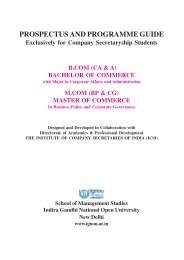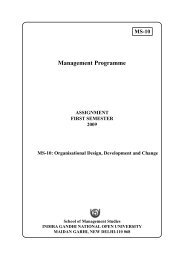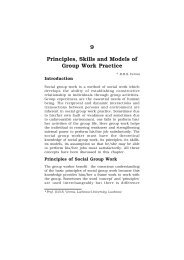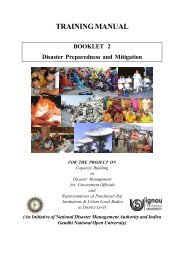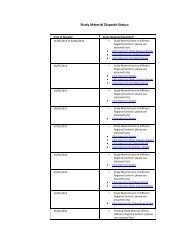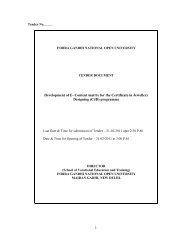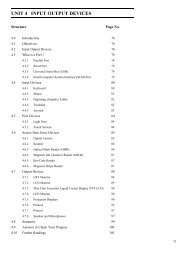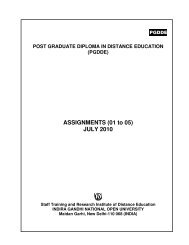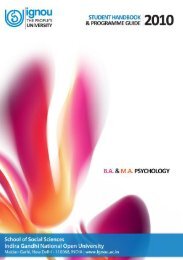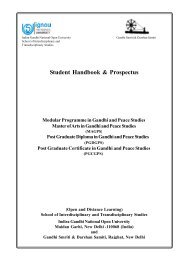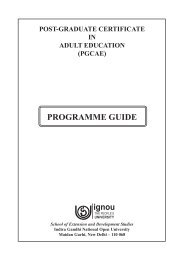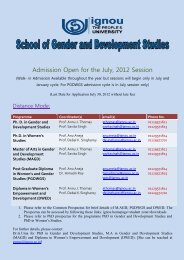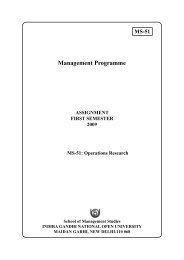Disaster Recovery and the Road Ahead - IGNOU
Disaster Recovery and the Road Ahead - IGNOU
Disaster Recovery and the Road Ahead - IGNOU
You also want an ePaper? Increase the reach of your titles
YUMPU automatically turns print PDFs into web optimized ePapers that Google loves.
(2005) held in Kobe, Hyogo, Japan has adopted a Framework for Action (2005-2015) on “Building<br />
<strong>the</strong> Resilience of Nations <strong>and</strong> Communities to <strong>Disaster</strong>s”. It is a positive step, as <strong>the</strong> Conference<br />
has provided a unique opportunity to promote a strategic <strong>and</strong> systematic approach to reducing risks<br />
<strong>and</strong> vulnerabilities to hazards. We have learnt about national organizations such as <strong>the</strong> NDMA,<br />
government departments, ministries doing substantial work in disaster management. However, <strong>the</strong>re<br />
are many International Treaties, Forums <strong>and</strong> Conferences, which have also reiterated <strong>the</strong> relevance<br />
of CBDM. Management of disasters is acquiring a global connotation. Besides <strong>the</strong> United Nations<br />
<strong>and</strong> <strong>the</strong> World Bank, many international organizations such as Caritas India, Lu<strong>the</strong>ran World Service,<br />
Asian Development Bank, Intermediate Technology Development Group (ITDG), Danish International<br />
Development Agency, Swedish International Development Agency, Cooperative for Assistance <strong>and</strong><br />
Relief Everywhere (CARE), Sustainable Environment <strong>and</strong> Ecological Development (SEEDS),<br />
International Federation of Red Cross <strong>and</strong> Red Crescent Societies, Oxfam, etc., are doing substantial<br />
work in <strong>the</strong> area of disaster relief, rehabilitation <strong>and</strong> recovery.<br />
2.2 SUSTAINABLE DEVELOPMENT FRAMEWORK<br />
In order to promote environmental protection <strong>and</strong> create long-term vulnerability reduction conditions,<br />
a ‘sustainable livelihood framework’ is urgently required. The livelihood approach advocates an<br />
increase in economic opportunities of work without degrading <strong>the</strong> natural environment. It aims at:<br />
<br />
<br />
<br />
<br />
<br />
<br />
Underst<strong>and</strong>ing <strong>the</strong> many factors, which influence people’s choices<br />
Creating livelihood options<br />
Pursuing equitable <strong>and</strong> environment friendly growth<br />
Involving both content <strong>and</strong> quality of growth<br />
Preventing acts of nature from becoming disasters<br />
Mitigating <strong>the</strong> conflict between development <strong>and</strong> environment<br />
DID YOU KNOW<br />
Sustainable living patterns have always<br />
been an integral part of rural India. There<br />
has been a long tradition of living in<br />
harmony with nature. Traditional practices<br />
of water conservation such as ‘Kuhls’ of<br />
Himachal Pradesh, ‘Kundis’ <strong>and</strong> ‘Rapats’<br />
of Rajasthan <strong>and</strong> ‘Palliyals’ of Kerala have<br />
held people in good stead against low<br />
intensity droughts. We have learnt about<br />
many environment-friendly traditional<br />
practices in this Manual. People have<br />
followed traditional practices of coping with<br />
Source: The Renaissance of Rainwater/<br />
benettontalk.com<br />
disasters, but are now increasingly becoming dependent on external agencies to withst<strong>and</strong><br />
<strong>the</strong> disaster aftermath. These traditional practices are being ab<strong>and</strong>oned to make way<br />
for new technologies. At a time when we need a thoughtful blend of <strong>the</strong> ‘old’ <strong>and</strong> <strong>the</strong><br />
‘new’, we are slowly loosing our traditional wisdom to a haphazard approach to modern<br />
development.<br />
53



